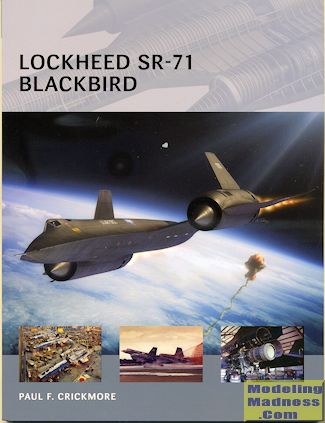 Undoubtedly one of the highlight aircraft designs of the 20th Century was the
Lockheed Blackbird. The majority of the public with any interest in aviation
knows about the SR-71, an aircraft that still holds a number of speed records
for manned aircraft with air breathing engines.
Undoubtedly one of the highlight aircraft designs of the 20th Century was the
Lockheed Blackbird. The majority of the public with any interest in aviation
knows about the SR-71, an aircraft that still holds a number of speed records
for manned aircraft with air breathing engines.
A previous volume, Air Vanguard #12, covered the CIA's A-11 and the
USAF's YF-12 as well as the development of the airframe. The SR-71 was pretty
much the same plane from the cockpit on back and in many ways was a combination
of the A-11's nose and the two seat configuration of the YF-12. Initially
developed as a high speed bomber with reconnaissance cababilities, (hence the
#71 in its designation to follow the B-70, it was realized that what was
actually needed was a recce bird. It was initially called the RS-71 for
reconnaissance/strike, but thanks to a Texan in the White House, who not only
blabbed about what was a secret project, but reversed the designation, it became
the SR-71.
With the SR-71 coming on line, partisan politics came into play and the
CIA lost their handle on high speed recce birds with the A-11 program being
terminated about the same time that the SR-71 started operations. To be sure,
the SR-71 was really a superior platform for the sorts of missions it was to
undertake as it had better cameras than the CIA's plane, so overall, nothing was
lost.
The aircraft went on through the late 1960s, through the 70s and 80s
performing its mission of photographing areas of the world where crises were
developing or underway. This includes Vietnam, flights just outside the coast of
China, along the DMZ in Korea as well as the Israeli/Arab wars and Bush Sr's
Gulf War among the many where the aircraft was used. Its ability to take photos
and have them in the hands of commander's in the field in a very short time was
one of the reasons to do manned reconnaissance.
With the improvement of satellite optics as well as the increasing cost
of operating a small fleet of planes, it was decided to retire the SR-71 so in
October 1989, SR-71 operations were suspended and in January of 1990, the SR-71
was fully retired. Cue the first Iraq War less than 7 months later and there was
suddenly a need once again, but then SecDef Dick Cheney vetoed the return of the
plane stating that he '..had already retired the plane once and wasn't going to
do it again.' So the SR-71 stayed in mothballs save for a few operated by NASA.
Come 1995 and N. Korea is doing some major sabre rattling. Three planes
are taken out of storage once funding has been renewed and the plane is flying
again. This lasts until mid 1996 when the candy money runs out. Further attempts
are made to keep the program going, but in 1997, it is retired once again and
for the final time. So the history of high speed manned reconnaissance in one of
the coolest looking planes to ever take to the skies is over. For those of us
who have seen the plane fly, it is a sight we will never forget. Now satellites
are the major source of strategic recce as are the more and more ubiquitous
drones.
In this book, the author continues the tale of the Blackbird. Filled
with great photos and equally great stories and information, the reader is able
to follow the history and some of the tribulations of this aircraft. Enhanced by
some great artwork, it is a book that any fan of the plane simply has to have on
their bookshelf.
May 2015
For more on the complete line of Osprey books,
visit http://ospreygrp.com. In the US, it is
Osprey Direct at 44-02 23rd St, Suite 219, Long Island City, NY 11101., where you can
get a catalogue of available books.
If you would like your product reviewed fairly and
fairly quickly, please
contact
the editor or see other details in the
Note to
Contributors.
 Undoubtedly one of the highlight aircraft designs of the 20th Century was the
Lockheed Blackbird. The majority of the public with any interest in aviation
knows about the SR-71, an aircraft that still holds a number of speed records
for manned aircraft with air breathing engines.
Undoubtedly one of the highlight aircraft designs of the 20th Century was the
Lockheed Blackbird. The majority of the public with any interest in aviation
knows about the SR-71, an aircraft that still holds a number of speed records
for manned aircraft with air breathing engines.